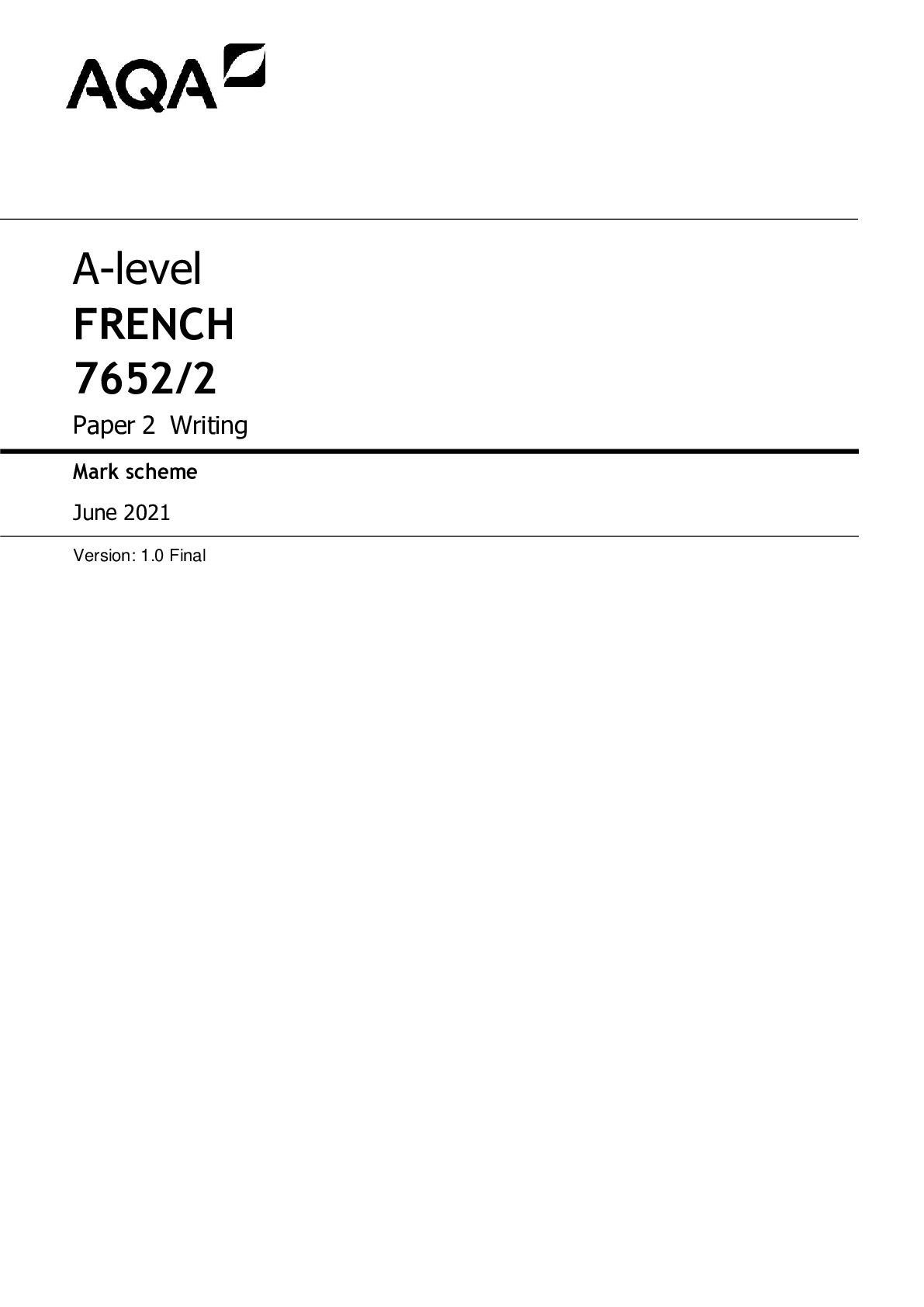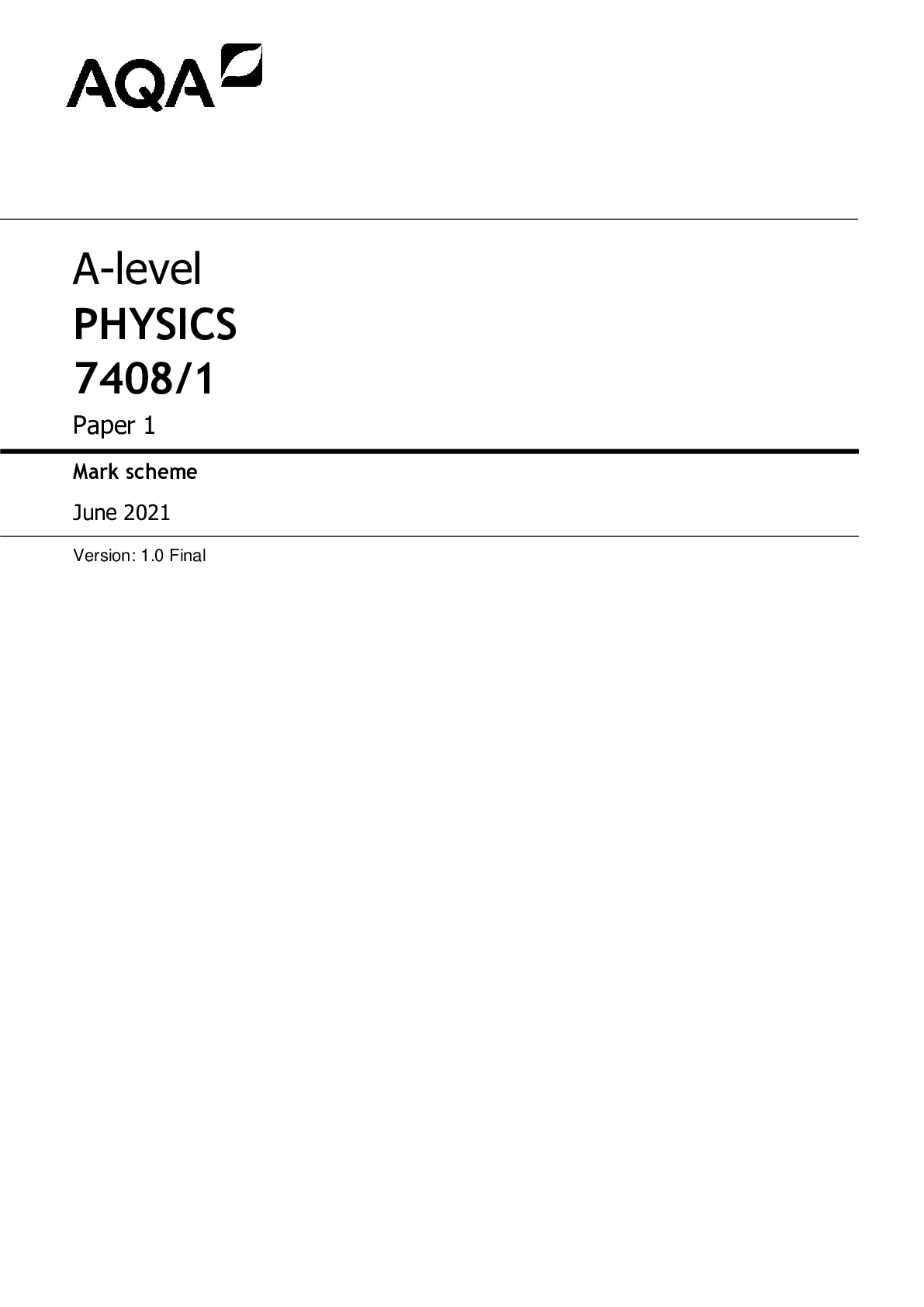Chemistry > A-Level Mark Scheme > AQA AS Level CHEMISTRY 7404/2 Paper 2 Organic and Physical Chemistry Mark Scheme June 2021 (All)
AQA AS Level CHEMISTRY 7404/2 Paper 2 Organic and Physical Chemistry Mark Scheme June 2021
Document Content and Description Below
AQA AS Level CHEMISTRY 7404/2 Paper 2 Organic and Physical Chemistry Mark Scheme June 2021 / AQA AS Level CHEMISTRY 7404-2 Paper 2 Organic and Physical Chemistry Mark Scheme June 2021 / AQA AS Level C... HEMISTRY Paper 2 Organic and Physical Chemistry Mark Scheme June 2021 AS CHEMISTRY 7404/2 Paper 2 Organic and Physical Chemistry Mark scheme June 2021 Version: 1.0 Final *216A74042/MS* MARK SCHEME – AS CHEMISTRY – 7404/2 – JUNE 2021 2 Mark schemes are prepared by the Lead Assessment Writer and considered, together with the relevant questions, by a panel of subject teachers. This mark scheme includes any amendments made at the standardisation events which all associates participate in and is the scheme which was used by them in this examination. The standardisation process ensures that the mark scheme covers the students’ responses to questions and that every associate understands and applies it in the same correct way. As preparation for standardisation each associate analyses a number of students’ scripts. Alternative answers not already covered by the mark scheme are discussed and legislated for. If, after the standardisation process, associates encounter unusual answers which have not been raised they are required to refer these to the Lead Examiner. It must be stressed that a mark scheme is a working document, in many cases further developed and expanded on the basis of students’ reactions to a particular paper. Assumptions about future mark schemes on the basis of one year’s document should be avoided; whilst the guiding principles of assessment remain constant, details will change, depending on the content of a particular examination paper. Further copies of this mark scheme are available from aqa.org.uk Copyright information AQA retains the copyright on all its publications. However, registered schools/colleges for AQA are permitted to copy material from this booklet for their own internal use, with the following important exception: AQA cannot give permission to schools/colleges to photocopy any material that is acknowledged to a third party even for internal use within the centre. Copyright © 2021 AQA and its licensors. All rights reserved. MARK SCHEME – AS CHEMISTRY – 7404/2 – JUNE 2021 3 AS and A-Level Chemistry Mark Scheme Instructions for Examiners 1. General The mark scheme for each question shows: • the marks available for each part of the question • the total marks available for the question • the typical answer or answers which are expected • extra information to help the examiner make his or her judgement and help to delineate what is acceptable or not worthy of credit or, in discursive answers, to give an overview of the area in which a mark or marks may be awarded. The extra information in the ‘Comments’ column is aligned to the appropriate answer in the left-hand part of the mark scheme and should only be applied to that item in the mark scheme. You should mark according to the contents of the mark scheme. If you are in any doubt about applying the mark scheme to a particular response, consult your Team Leader. At the beginning of a part of a question a reminder may be given, for example: where consequential marking needs to be considered in a calculation; or the answer may be on the diagram or at a different place on the script. In general the right-hand side of the mark scheme is there to provide those extra details which might confuse the main part of the mark scheme yet may be helpful in ensuring that marking is straightforward and consistent. The use of M1, M2, M3 etc in the right-hand column refers to the marking points in the order in which they appear in the mark scheme. So, M1 refers to the first marking point, M2 the second marking point etc. 2. Emboldening 2.1 In a list of acceptable answers where more than one mark is available ‘any two from’ is used, with the number of marks emboldened. Each of the following bullet points is a potential mark. 2.2 A bold and is used to indicate that both parts of the answer are required to award the mark. 2.3 Alternative answers acceptable for a mark are indicated by the use of OR. Different terms in the mark scheme are shown by a / ; eg allow smooth / free movement. 3. Marking points 3.1 Marking of lists This applies to questions requiring a set number of responses, but for which students have provided extra responses. The general ‘List’ principle to be followed in such a situation is that ‘right + wrong = wrong’. Each error / contradiction negates each correct response. So, if the number of error / contradictions equals or exceeds the number of marks available for the question, no marks can be awarded. However, responses considered to be neutral (often prefaced by ‘Ignore’ in the mark scheme) are not penalised. MARK SCHEME – AS CHEMISTRY – 7404/2 – JUNE 2021 4 For example, in a question requiring 2 answers for 2 marks: Correct answers Incorrect answers (ie incorrect rather than neutral) Mark (2) Comment 1 0 1 1 1 1 They have not exceeded the maximum number of responses so there is no penalty. 1 2 0 They have exceeded the maximum number of responses so the extra incorrect response cancels the correct one. 2 0 2 2 1 1 2 2 0 3 0 2 The maximum mark is 2 3 1 1 The incorrect response cancels out one of the two correct responses that gained credit. 3 2 0 Two incorrect responses cancel out the two marks gained. 3 3 0 3.2 Marking procedure for calculations Full marks should be awarded for a correct numerical answer, without any working shown, unless the question states ‘Show your working’ or ‘justify your answer’. In this case, the mark scheme will clearly indicate what is required to gain full credit. If an answer to a calculation is incorrect and working is shown, process mark(s) can usually be gained by correct substitution / working and this is shown in the ‘Comments’ column or by each stage of a longer calculation. 3.3 Errors carried forward, consequential marking and arithmetic errors Allowances for errors carried forward are most likely to be restricted to calculation questions and should be shown by the abbreviation ECF or consequential in the marking scheme. An arithmetic error should be penalised for one mark only unless otherwise amplified in the marking scheme. Arithmetic errors may arise from a slip in a calculation or from an incorrect transfer of a numerical value from data given in a question. 3.4 Equations In questions requiring students to write equations, state symbols are generally ignored unless otherwise stated in the ‘Comments’ column. Examiners should also credit correct equations using multiples and fractions unless otherwise stated in the ‘Comments’ column. MARK SCHEME – AS CHEMISTRY – 7404/2 – JUNE 2021 5 3.5 Oxidation states In general, the sign for an oxidation state will be assumed to be positive unless specifically shown to be negative. 3.6 Interpretation of ‘it’ Answers using the word ‘it’ should be given credit only if it is clear that the ‘it’ refers to the correct subject. 3.7 Phonetic spelling The phonetic spelling of correct scientific terminology should be credited unless there is a possible confusion with another technical term or if the question requires correct IUPAC nomenclature. 3.8 Brackets (…..) are used to indicate information which is not essential for the mark to be awarded but is included to help the examiner identify the sense of the answer required. 3.9 Ignore / Insufficient / Do not allow Ignore or insufficient is used when the information given is irrelevant to the question or not enough to gain the marking point. Any further correct amplification could gain the marking point. Do not allow means that this is a wrong answer which, even if the correct answer is given, will still mean that the mark is not awarded. 3.10 Marking crossed out work Crossed out work that has not been replaced should be marked as if it were not crossed out, if possible. Where crossed out work has been replaced, the replacement work and not the crossed out work should be marked. 3.11 Reagents The command word “Identify”, allows the student to choose to use either the name or the formula of a reagent in their answer. In some circumstances, the list principle may apply when both the name and the formula are used. Specific details will be given in mark schemes. The guiding principle is that a reagent is a chemical which can be taken out of a bottle or container. Failure to identify complete reagents will be penalised, but follow-on marks (e.g. for a subsequent equation or observation) can be scored from an incorrect attempt (possibly an incomplete reagent) at the correct reagent. Specific details will be given in mark schemes. For example, no credit would be given for • the cyanide ion or CN– when the reagent should be potassium cyanide or KCN; • the hydroxide ion or OH– when the reagent should be sodium hydroxide or NaOH; MARK SCHEME – AS CHEMISTRY – 7404/2 – JUNE 2021 6 • the Ag(NH3)2+ ion when the reagent should be Tollens’ reagent (or ammoniacal silver nitrate). In this example, no credit is given for the ion, but credit could be given for a correct observation following on from the use of the ion. Specific details will be given in mark schemes. In the event that a student provides, for example, both KCN and cyanide ion, it would be usual to ignore the reference to the cyanide ion (because this is not contradictory) and credit the KCN. Specific details will be given in mark schemes. 3.12 Organic structures Where students are asked to draw organic structures, unless a specific type is required in the question and stated in the mark scheme, these may be given as displayed, structural or skeletal formulas or a combination of all three as long as the result is unambiguous. In general • Displayed formulae must show all of the bonds and all of the atoms in the molecule, but need not show correct bond angles. • Skeletal formulae must show carbon atoms by an angle or suitable intersection in the skeleton chain. Functional groups must be shown and it is essential that all atoms other than C atoms are shown in these (except H atoms in the functional groups of aldehydes, secondary amines and N-substituted amides which do not need to be shown). • Structures must not be ambiguous, eg 1-bromopropane should be shown as CH3CH2CH2Br and not as the molecular formula C3H7Br which could also represent the isomeric 2-bromopropane. • Bonds should be drawn correctly between the relevant atoms. This principle applies in all cases where the attached functional group contains a carbon atom, eg nitrile, carboxylic acid, aldehyde and acid chloride. The carbon-carbon bond should be clearly shown. Wrongly bonded atoms will be penalised on every occasion. (see the examples below) • The same principle should also be applied to the structure of alcohols. For example, if students show the alcohol functional group as C ─ HO, they should be penalised on every occasion. • Latitude should be given to the representation of C ─ C bonds in alkyl groups, given that CH3─ is considered to be interchangeable with H3C─ even though the latter would be preferred. • Similar latitude should be given to the representation of amines where NH2─ C will be allowed, although H2N─ C would be preferred. • Poor presentation of vertical C ─ CH3 bonds or vertical C ─ NH2 bonds should not be penalised. For other functional groups, such as ─ OH and ─ CN, the limit of tolerance is the half-way position between the vertical bond and the relevant atoms in the attached group. MARK SCHEME – AS CHEMISTRY – 7404/2 – JUNE 2021 7 By way of illustration, the following would apply. CH3C CCH3 CCH3CH2 OHC COH allowed allowed not allowed not allowed not allowed NH2C CNH2 NH2 NH2 NO2 allowed allowed allowed allowed not allowed CNC CCN COOHC CCOOH CCOOH not allowed not allowed not allowed not allowed not allowed CHOC CCHO CCHO COClC CCOCl not allowed not allowed not allowed not allowed not allowed • Representation of CH2 by C−H2 will be penalised • Some examples are given here of structures for specific compounds that should not gain credit (but, exceptions may be made in the context of balancing equations) CH3COH for ethanal CH3CH2HO for ethanol OHCH2CH3 for ethanol C2H6O for ethanol CH2CH2 for ethene CH2.CH2 for ethene CH2:CH2 for ethene • Each of the following should gain credit as alternatives to correct representations of the structures. CH2 = CH2 for ethene, H2C=CH2 CH3CHOHCH3 for propan-2-ol, CH3CH(OH)CH3 MARK SCHEME – AS CHEMISTRY – 7404/2 – JUNE 2021 8 • In most cases, the use of “sticks” to represent C ─ H bonds in a structure should not be penalised. The exceptions to this when “sticks” will be penalised include • structures in mechanisms where the C ─ H bond is essential (e.g. elimination reactions in halogenoalkanes and alcohols) • when a displayed formula is required • when a skeletal structure is required or has been drawn by the candidate 3.13 Organic names As a general principle, non-IUPAC names or incorrect spelling or incomplete names should not gain credit. Some illustrations are given here. Unnecessary but not wrong numbers will not be penalised such as the number ‘2’ in 2-methylpropane or the number ‘1’ in 2-chlorobutan-1-oic acid. but-2-ol should be butan-2-ol 2-hydroxybutane should be butan-2-ol butane-2-ol should be butan-2-ol 2-butanol should be butan-2-ol ethan-1,2-diol should be ethane-1,2-diol 2-methpropan-2-ol should be 2-methylpropan-2-ol 2-methylbutan-3-ol should be 3-methylbutan-2-ol 3-methylpentan should be 3-methylpentane 3-mythylpentane should be 3-methylpentane 3-methypentane should be 3-methylpentane propanitrile should be propanenitrile aminethane should be ethylamine (although aminoethane can gain credit) 2-methyl-3-bromobutane should be 2-bromo-3-methylbutane 3-bromo-2-methylbutane should be 2-bromo-3-methylbutane 3-methyl-2-bromobutane should be 2-bromo-3-methylbutane 2-methylbut-3-ene should be 3-methylbut-1-ene difluorodichloromethane should be dichlorodifluoromethane MARK SCHEME – AS CHEMISTRY – 7404/2 – JUNE 2021 9 3.14 Organic reaction mechanisms Curly arrows should originate either from a lone pair of electrons or from a bond. The following representations should not gain credit and will be penalised each time within a clip. CH3BrCH3BrCH3Br....OH OH.. __: For example, the following would score zero marks. H3CCHHBrHO When the curly arrow is showing the formation of a bond to an atom, the arrow can go directly to the relevant atom, alongside the relevant atom or more than half-way towards the relevant atom. In free-radical substitution: • the absence of a radical dot should be penalised once only within a clip • the use of half-headed arrows is not required, but the use of double-headed arrows or the incorrect use of half-headed arrows in free-radical mechanisms should be penalised once only within a clip. The correct use of skeletal formulae in mechanisms is acceptable, but where a C-H bond breaks, both the bond and the H must be drawn to gain credit. 3.15 Extended responses For questions marked using a ‘Levels of Response’ mark scheme: Level of response mark schemes are broken down into three levels, each of which has a descriptor. Each descriptor contains two statements. The first statement is the Chemistry content statement and the second statement is the communication statement. Determining a level Start at the lowest level of the mark scheme and use it as a ladder to see whether the answer meets the Chemistry content descriptor for that level. The descriptor for the level indicates the qualities that might be seen in the student’s answer for that level. If it meets the lowest level, then go to the next one and decide if it meets this level, and so on, until you have a match between the level descriptor and the answer. MARK SCHEME – AS CHEMISTRY – 7404/2 – JUNE 2021 10 When assigning a level you should look at the overall quality of the answer and not look to pick holes in small and specific parts of the answer where the student has not performed quite as well as the rest. If the answer covers different aspects of different levels of the mark scheme you should use a best fit approach for defining the level. Once the level has been decided, the mark within the level is determined by the communication statement: • If the answer completely matches the communication descriptor, award the higher mark within the level. • If the answer does not completely match the communication descriptor, award the lower mark within the level. The exemplar materials used during standardisation will help you to determine the appropriate level. There will be an exemplar in the standardising materials which will correspond with each level of the mark scheme and for each mark within each level. This answer will have been awarded a mark by the Lead Examiner. You can compare the student’s answer with the exemplar to determine if it is the same standard, better or worse than the example. You can then use this to allocate a mark for the answer based on the Lead Examiner’s mark on the exemplar. You may well need to read back through the answer as you apply the mark scheme to clarify points and assure yourself that the level and the mark are appropriate. Indicative content in the mark scheme is provided as a guide for examiners. It is not intended to be exhaustive and you must credit other chemically valid points. Students may not have to cover all of the points mentioned in the indicative content to reach the highest level of the mark scheme. The mark scheme will state how much chemical content is required for the highest level. An answer which contains nothing of relevance to the question must be awarded no marks. For other extended response answers: Where a mark scheme includes linkage words (such as ‘therefore’, ‘so’, ‘because’ etc), these are optional. However, a student’s marks for the question may be limited if they do not demonstrate the ability to construct and develop a sustained line of reasoning which is coherent, relevant, substantiated and logically structured. In particular answers in the form of bullet pointed lists may not be awarded full marks if there is no indication of logical flow between each point or if points are in an illogical order. The mark schemes for some questions state that the maximum mark available for an extended response answer is limited if the answer is not coherent, relevant, substantiated and logically structured. During the standardisation process, the Lead Examiner will provide marked exemplar material to demonstrate answers which have not met these criteria. You should use these exemplars as a comparison when marking student answers. MARK SCHEME – AS CHEMISTRY – 7404/2 – JUNE 2021 11 Question Marking guidance Additional Comments/Guidelines Mark 01.1 Number of molecules (with a particular energy) Ignore particles / atoms Allow amount or fraction or proportion for number 1 Question Marking guidance Additional Comments/Guidelines Mark 01.2 There are no molecules with no energy All molecules / particles have some energy Allow particles / atoms 1 Question Marking guidance Additional Comments/Guidelines Mark 01.3 Most probable / common / modal energy 1 Question Marking guidance Additional Comments/Guidelines Mark 01.4 M1 Peak should be at same energy (i.e. in line with X) M2 Overall area should be half the original area; after diverging from the origin, the second line should not touch the first line M1 and M2 marked independently M2 area should be about half of the original 1 1 MARK SCHEME – AS CHEMISTRY – 7404/2 – JUNE 2021 12 Question Marking guidance Additional Comments/Guidelines Mark 02.1 M1 electrophilic addition M2 must show an arrow from the double bond towards a Br atom in a Br–Br molecule M3 must show the breaking of the Br–Br bond M4 is for the structure of the correct carbocation M5 must show an arrow from the lone pair of electrons on the Br– towards the positively charged atom of their carbocation All arrows are double-headed. Penalise one mark from the total for M2-5 if half headed arrows are used. Do not penalise the “correct” use of “sticks” Penalise only once in any part of the mechanism for a line and two dots to show a bond M2 ignore partial negative charges on the double bond M3 penalise incorrect partial charges on the Br–Br bond and penalise formal charges Penalise M4 if there is a bond drawn to the positive charge Max 3 of 4 marks (M2-5) for wrong organic reactant or wrong carbocation (ignore structure of product) For M5, credit attack on a partially positively charged carbocation structure, but penalise M4 for the structure of the carbocation 1 1 1 1 1 Question Marking guidance Additional Comments/Guidelines Mark 02.2 M1 C=C electron rich / area of high electron density M2 Br-Br becomes polarised M3 δ+ Br attracted to C=C M1 ignore idea that C=C is negative or highly electronegative 1 1 1 MARK SCHEME – AS CHEMISTRY – 7404/2 – JUNE 2021 13 Question Marking guidance Additional Comments/Guidelines Mark 02.3 Must be skeletal structure 1 MARK SCHEME – AS CHEMISTRY – 7404/2 – JUNE 2021 14 Question Marking Guidance Additional Comments/Guidelines Mark 03.1 This question is marked using levels of response. Refer to the Mark Scheme Instructions for Examiners for guidance on how to mark this question. Stage 1 Anti-bumping granules 1a no anti-bumping granules / add anti-bumping granules 1b to create smaller bubbles / to prevent large bubbles / to prevent mixture jumping into condenser Stage 2 Open system with no thermometer 2a system should be closed (above flask) to prevent gases escaping 2b should be closed with (bung +) thermometer 2c to allow collection of propanone (only) / to prevent distillation of other components / to stay in suitable temperature range Stage 3 The water direction in the condenser 3a water flows in wrong direction through condenser / change water direction 3b condenser not cool enough / not full of water 3c product may not condense / comes through as gas 6 Level 3 (5–6 marks) All stages are covered and each stage is generally correct and virtually complete (6 v 5) Answer is well structured, with no repetition or irrelevant points, and covers all aspects of the question. Accurate and clear expression of ideas with no errors in use of technical terms. Level 2 (3–4 marks) All stages are covered but stage(s) may be incomplete or may contain inaccuracies OR two stages are covered and are generally correct and virtually complete (4 v 3) Answer has some structure and covers most aspects of the question. Ideas are expressed with reasonable clarity with, perhaps, some repetition or some irrelevant points. If any, only minor errors in use of technical terms. Level 1 (1–2 marks) Two stages are covered but stage(s) may be incomplete or may contain inaccuracies OR only one stage is covered but is generally correct and virtually complete (2 v 1) Answer includes statements which are presented in a logical order and/or linked. 0 marks Insufficient correct chemistry to gain a mark. MARK SCHEME – AS CHEMISTRY – 7404/2 – JUNE 2021 15 Question Marking guidance Additional Comments/Guidelines Mark 03.2 M1 mass of propan-2-ol = 2.0 x 0.786 (= 1.572 g to at least 2sf) M2 amount of propan-2-ol = 1.572 60.0 ( = 0.0262 to at least 2 sf) mol M3 mass of propanone expected = 0.0262 x 58.0 ( = 1.52 g to at least 2sf) M4 % yield = ?0.9541.52 ?? 100? = 63% (2sf only) Alternative for M3/4 M3 amount of propanone formed = 0.954 58.0 ( = 0.0164) mol M4 % yield = ?0.01640.0262 ?? 100? = 63% (2sf only) Allow ECF at each step 1 1 1 1 Question Marking guidance Additional Comments/Guidelines Mark 03.3 M1 propan-2-ol: tetrahedral and 109.5° M2 propanone: trigonal planar and 120° M1 allow 104–110° M2 allow 115–123° Any two correct boxes scores one mark 1 1 MARK SCHEME – AS CHEMISTRY – 7404/2 – JUNE 2021 16 Question Marking guidance Additional Comments/Guidelines Mark 03.4 M1 propan-2-ol has stronger intermolecular forces M2 propan-2-ol has hydrogen bonds between molecules M3 propanone has dipole-dipole forces and/or van der Waals’ forces Penalise M1 and M2 for any reference to breaking covalent bonds, (but M3 could score) For M2 ignore reference to dipole-dipole forces in propan-2-ol 1 1 1 MARK SCHEME – AS CHEMISTRY – 7404/2 – JUNE 2021 17 Question Marking guidance Additional Comments/Guidelines Mark 04.1 trichlorofluoromethane 1 Question Marking guidance Additional Comments/Guidelines Mark 04.2 CCl3F → •CCl2F + •Cl radical dot anywhere on each radical 1 Question Marking guidance Additional Comments/Guidelines Mark 04.3 M1 amount of CFC-11 = 500137.5 ( = 3.64) mol M2 molecules of O3 = 3.64 x 100,000 x 6.022 x 1023 = 2.19 x 1029 Allow ECF from M1 to M2 Allow answers in range 2 x 1029 to 2.20 x 1029 (1sf is acceptable as this is an estimate) 1 1 MARK SCHEME – AS CHEMISTRY – 7404/2 – JUNE 2021 18 Question Marking guidance Additional Comments/Guidelines Mark 04.4 Absorbs (harmful) ultraviolet / uv (light / radiation) Protects us from (harmful) uv Ignore other wavelengths / types of light 1 Question Marking guidance Additional Comments/Guidelines Mark 04.5 One of these reasons: • lack of evidence that ozone was being depleted • lack of alternatives to CFCs • commercial interest to continue to use CFCs • hard to obtain international agreement 1 Question Marking guidance Additional Comments/Guidelines Mark 04.6 M1 absorbs infrared radiation M2 molecule has polar bonds M1 idea of IR being taken in M2 accept polar molecule 1 1 MARK SCHEME – AS CHEMISTRY – 7404/2 – JUNE 2021 19 Question Marking guidance Additional Comments/Guidelines Mark 05.1 Step 1 M1 fractional distillation M2 separated into mixtures of compounds with similar boiling points / similar sized molecules Step 2 M3 (thermal) cracking M4 to make alkenes / propene / shorter molecules Step 3 M5 (addition) polymerisation M6 molecules joined together or to produce long chain molecule For each step the two marks are independent M2 to separate naphtha from other compounds; to separate compounds by chain length / size / boiling point M3 not catalytic cracking M5 not condensation polymerisation 1 1 1 1 1 1 Question Marking guidance Additional Comments/Guidelines Mark 05.2 no polar bonds (in chain) / non-polar Do not allow if only C-H bonds mentioned as non polar 1 Question Marking guidance Additional Comments/Guidelines Mark 05.3 to prevent build-up of waste (in landfill) OR they can be broken down by natural processes 1 MARK SCHEME – AS CHEMISTRY – 7404/2 – JUNE 2021 20 Question Marking guidance Additional Comments/Guidelines Mark 06.1 METHOD 1 Stage 1 M1 ??= ???????? M2 converting P to 51.0 x 103, V to 482 x 10–6 M3 = 51.0 ?? 103 ?? 482 ?? 10−68.31 ?? 297 (= 0.00996) Stage 2 M4 converting mass to 0.717 M5 ???? ?= ?????????????????? ?= ???????? = 72.0 (at least 2 sf) METHOD 2 M1 ??= ???????? M2 ????= ?????????????? M3 converting P to 51.0 x 103, V to 482 x 10–6 M4 converting mass to 0.717 M5 ????= ?0.717 ?? 8.31 ?? 297 51.0 ?? 103 ?? 482 ?? 10−6 ? = 72.0 (at least 2 sf) Both methods: 72.0 can be achieved with incorrect working and may not score because individual steps need to be assessed as correct 72.0 with no working scores no marks If expression not written out, M1 could score from a substituted correct expression later on (even if any unit conversions are incorrect) METHOD 1 • ECF from M2 to M3 • ECF from M3 to M4 • ECF from M4 to M5 • Ignore units for M3 METHOD 2 • ECF from M3 to M4 • ECF from M2 to M4 • ECF from M4 to M5 1 1 1 1 1 MARK SCHEME – AS CHEMISTRY – 7404/2 – JUNE 2021 21 Question Marking guidance Additional Comments/Guidelines Mark 06.2 M1 amount of CO2 formed in flask = 0.008 mol M2 amount of gas in flask = 0.0075 (O2) + 0.0080 (M1) = 0.0155 mol Allow ECF from M1 to M2 1 1 MARK SCHEME – AS CHEMISTRY – 7404/2 – JUNE 2021 22 Question Marking guidance Additional Comments/Guidelines Mark 07.1 nucleophilic substitution 1 Question Marking guidance Additional Comments/Guidelines Mark 07.2 M1 elimination M2 arrow from lone pair on O to H+ M3 1st intermediate and arrow from C–O+H2 bond to O M4 2nd intermediate (carbocation) and arrow from a correct C–H bond to correct C–C to form C=C Max 2 of 3 marks (M2-4) for wrong organic reactant (ignore structure of product) M3 and M4 can be scored in one concurrent step: M3 for correct intermediate and arrow from C–O+H2 bond to O M4 for arrow from a correct C–H bond to correct C–C to form C=C 1 1 1 1 MARK SCHEME – AS CHEMISTRY – 7404/2 – JUNE 2021 23 Question Marking guidance Additional Comments/Guidelines Mark 07.3 Any correct structural representation Ignore any brackets and/or n 1 Question Marking guidance Additional Comments/Guidelines Mark 07.4 Structure in any form 1 MARK SCHEME – AS CHEMISTRY – 7404/2 – JUNE 2021 24 Question Marking guidance Additional Comments/Guidelines Mark 08.1 Heat (energy) change at constant pressure allow transfer for change 1 Question Marking guidance Additional Comments/Guidelines Mark 08.2 M1 correctly showing how many of which types of bonds are broken / made (broken) 2(C–C) + 8(C–H) + 5(O=O) (5776 + 2(C-C)) (made) 6(C=O) + 8(O–H) (8162) M2 including 4(41) for vaporisation of water M3 2(C–C) = 6(C=O) + 8(O–H) + 4(41) – 2046 – 8(C–H) – 5(O=O) = 6(743) + 8(463) + 4(41) – 2046 – 8(412) – 5(496) = 504 M4 (C–C) = ?????? = 252 (kJ mol–1) 252 scores 4 170 scores 3 (omits vaporisation of water) 168 scores 3 (3 C-C bonds) 113 scores 2 (3 C-C bonds & omits vaporisation of water) 88 scores 3 (vaporisation of water on wrong side) M1 is for identifying the number and type of bonds broken / made (does not have to explicit if they are broken or made, it is just which bonds and the number of each) M2 is for including 4(41) in some way in the calculation M3 is for calculating total for C-C bonds; allow 340 for 2 marks for omitting 4(41) M4 is for dividing their M3 by two (ie allow ECF from M3 to M4; ECF for 3(C-C) to divide their M3 by three) Ignore units 1 1 1 1 MARK SCHEME – AS CHEMISTRY – 7404/2 – JUNE 2021 25 Question Marking guidance Additional Comments/Guidelines Mark 08.3 Oxygen / O2 is the only substance that has O=O bond 1 MARK SCHEME – AS CHEMISTRY – 7404/2 – JUNE 2021 26 Question Marking Guidance Mark Comments 9 B 1 4-methylpent-2-ene 10 C 1 C2H4O2 11 B 1 1.74 x 10–2 12 D 1 •CH3 + Cl2 → CH3Cl + Cl• 13 B 1 3-methylhex-1-ene 14 D 1 butanenitrile 15 B 1 16 A 1 1-bromopropane, C–Br bond weaker than C–Cl bond 17 A 1 18 D 1 (CH3)2CHCH=CH2 MARK SCHEME – AS CHEMISTRY – 7404/2 – JUNE 2021 27 19 D 1 An increase in pressure increases the value of Kc 20 C 1 The rate of the reverse reaction increases. 21 B 1 22 A 1 It can be removed from car exhaust gases by a catalytic converter. 23 C 1 51 [Show More]
Last updated: 1 year ago
Preview 1 out of 27 pages
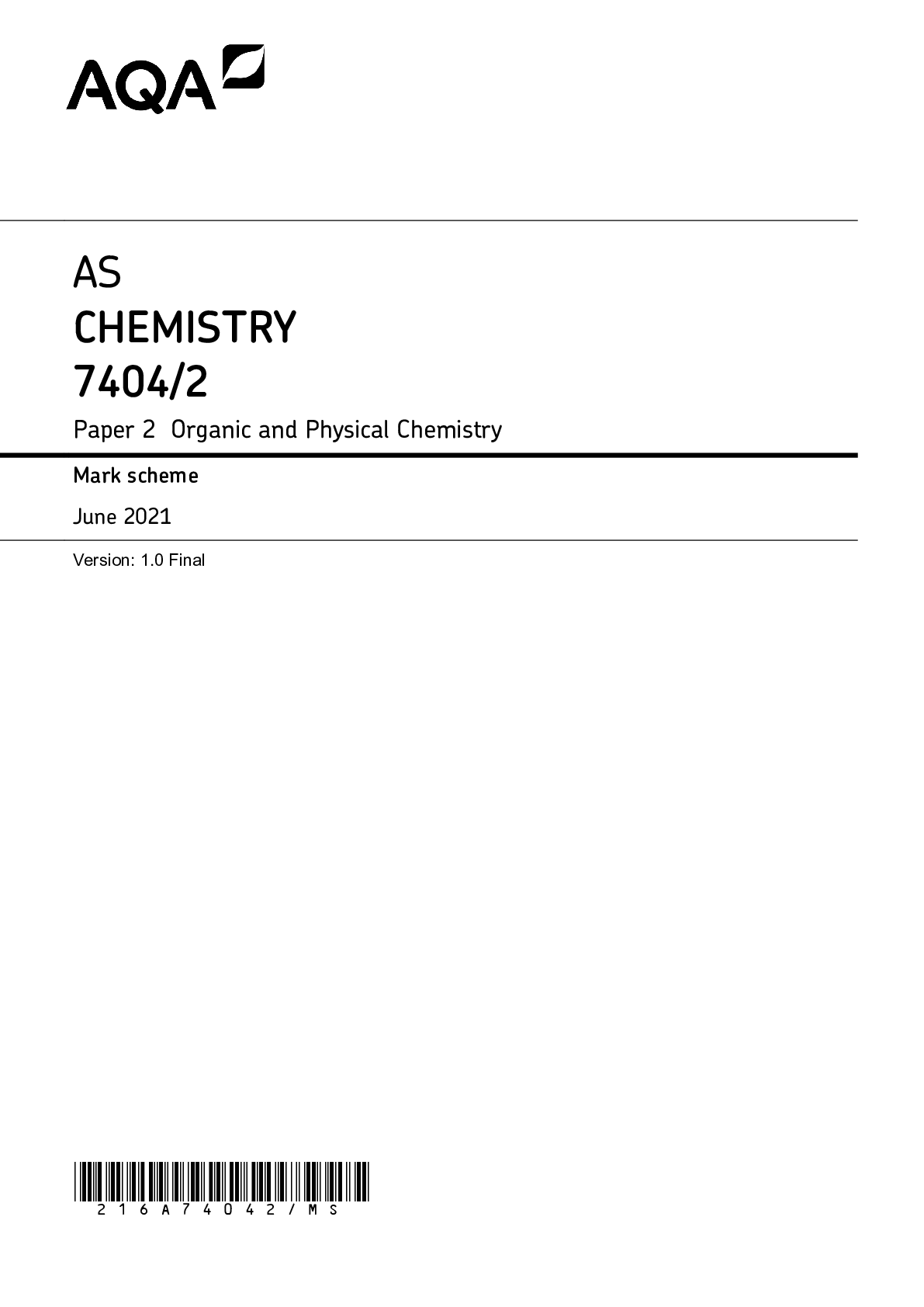
Also available in bundle (2)
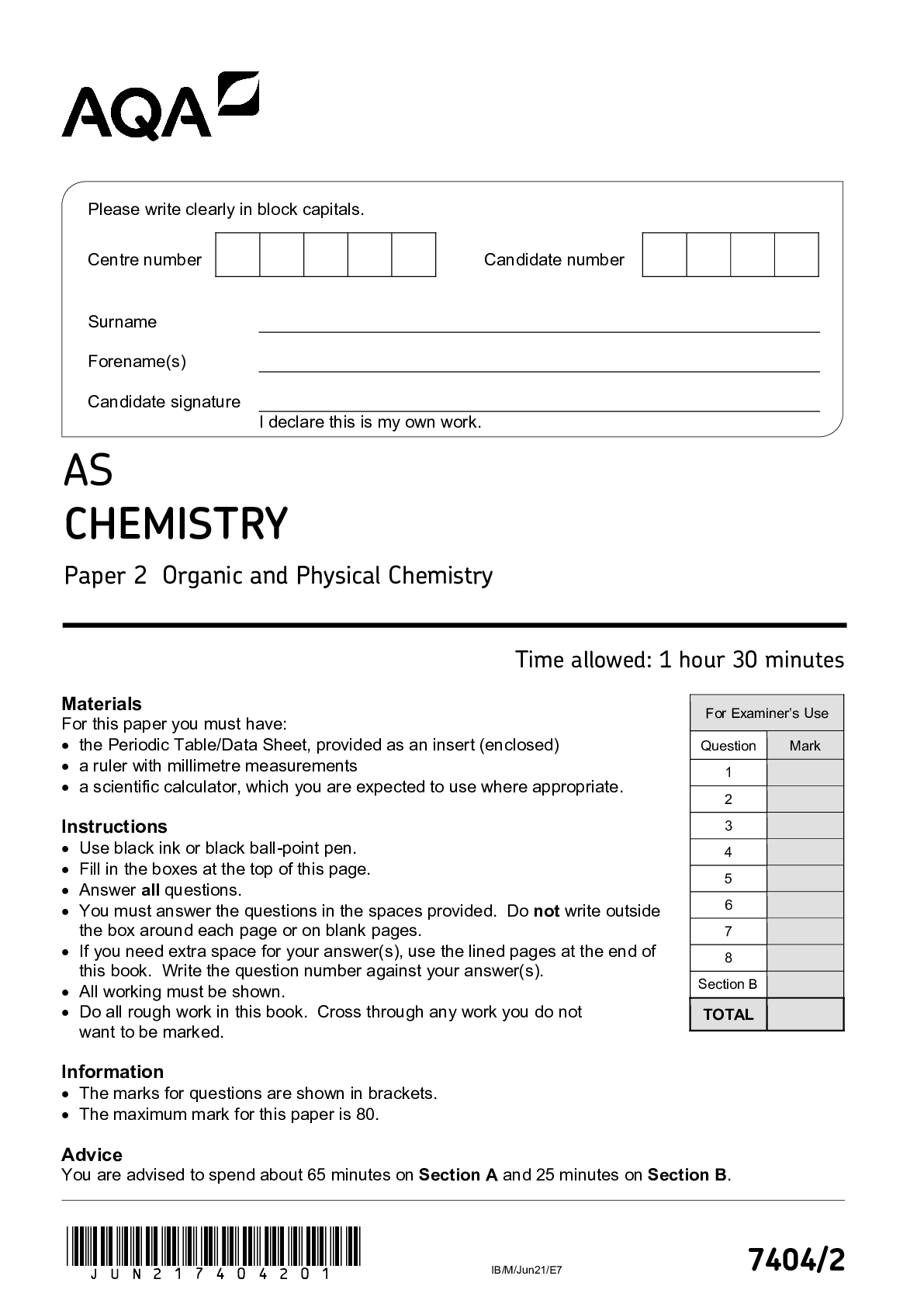
AQA AS Level CHEMISTRY 7404/2 Paper 2 and Mark Scheme June 2021 | Organic and Physical Chemistry
This bundle contains AS Level CHEMISTRY Paper 2 Question Paper and the VERIFIED MARK SCHEME AQA AS Level CHEMISTRY 7404/2 Paper 2 Organic and Physical Chemistry June 2021 | Question Paper AQA AS...
By Tests guru 1 year ago
$10
2

AS Level CHEMISTRY COMPLETE PACKAGE WITH VERIFIED MARK SCHEME
AQA AS Level CHEMISTRY 7404/2 Paper 2 Organic and Physical Chemistry June 2021 | Question Paper AQA AS Level CHEMISTRY 7404/2 Paper 2 Organic and Physical Chemistry Mark Scheme June 2021 AQA AS...
By Tests guru 1 year ago
$17
4
Reviews( 0 )
Document information
Connected school, study & course
About the document
Uploaded On
Jul 06, 2022
Number of pages
27
Written in
Additional information
This document has been written for:
Uploaded
Jul 06, 2022
Downloads
0
Views
42

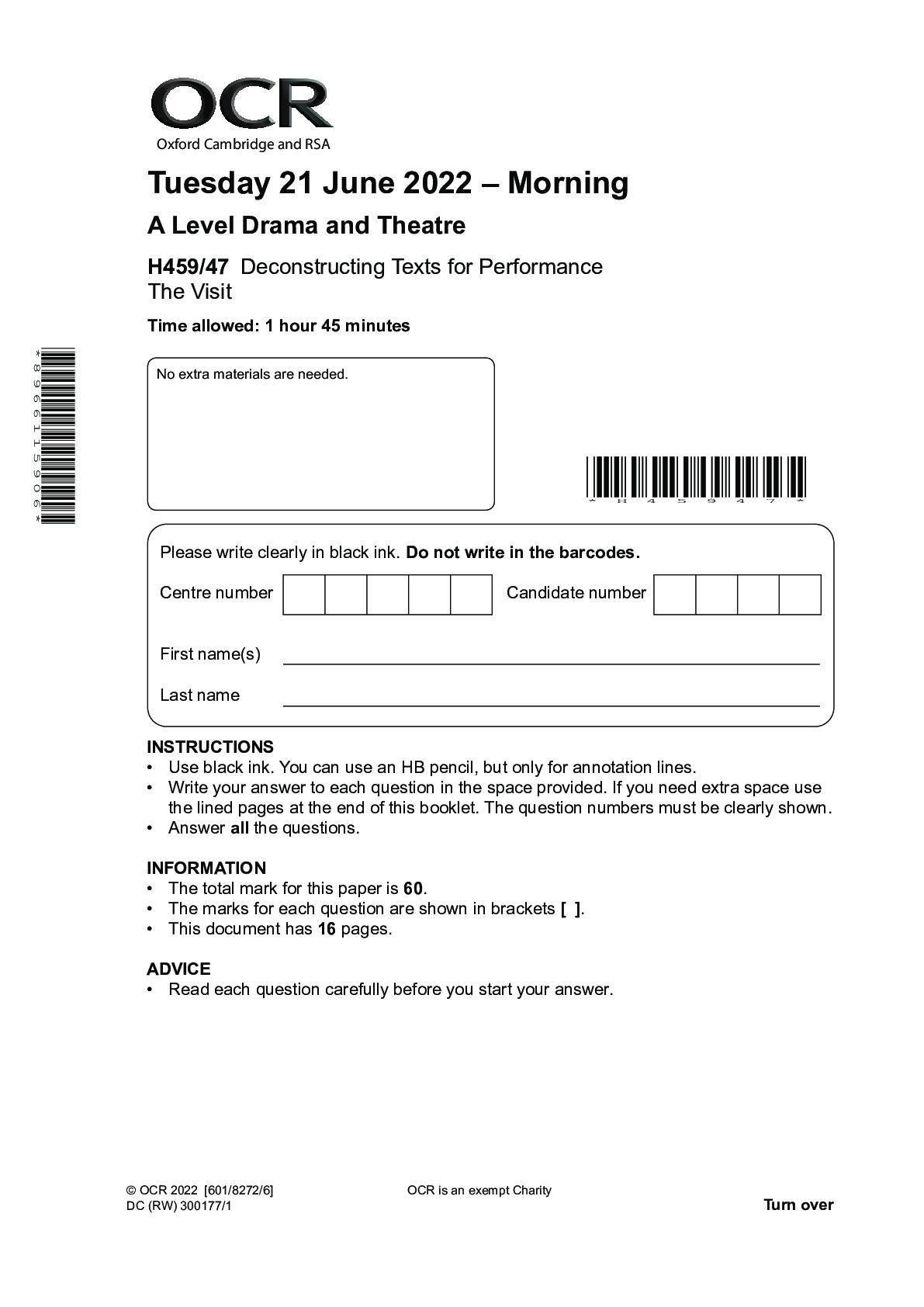
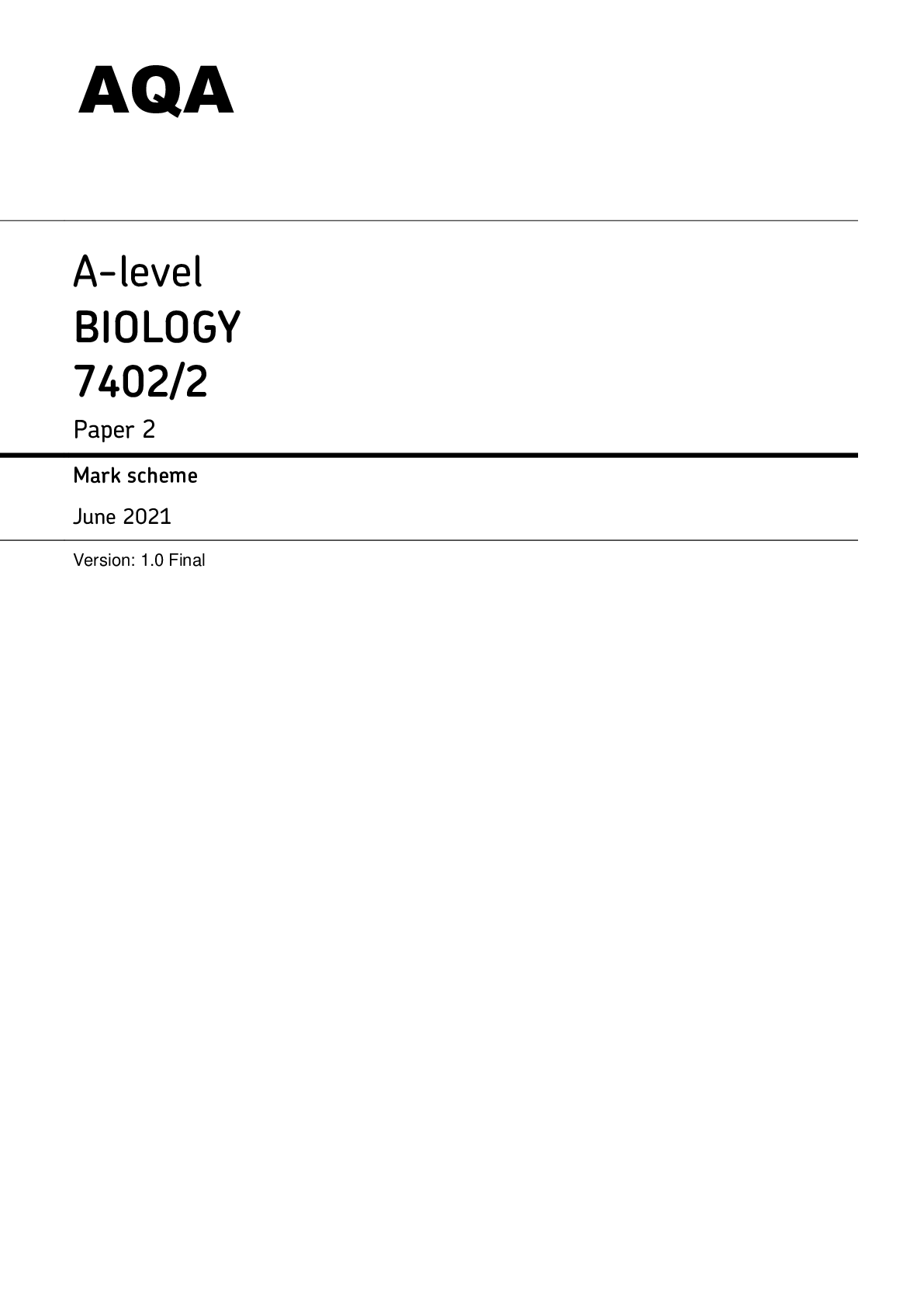
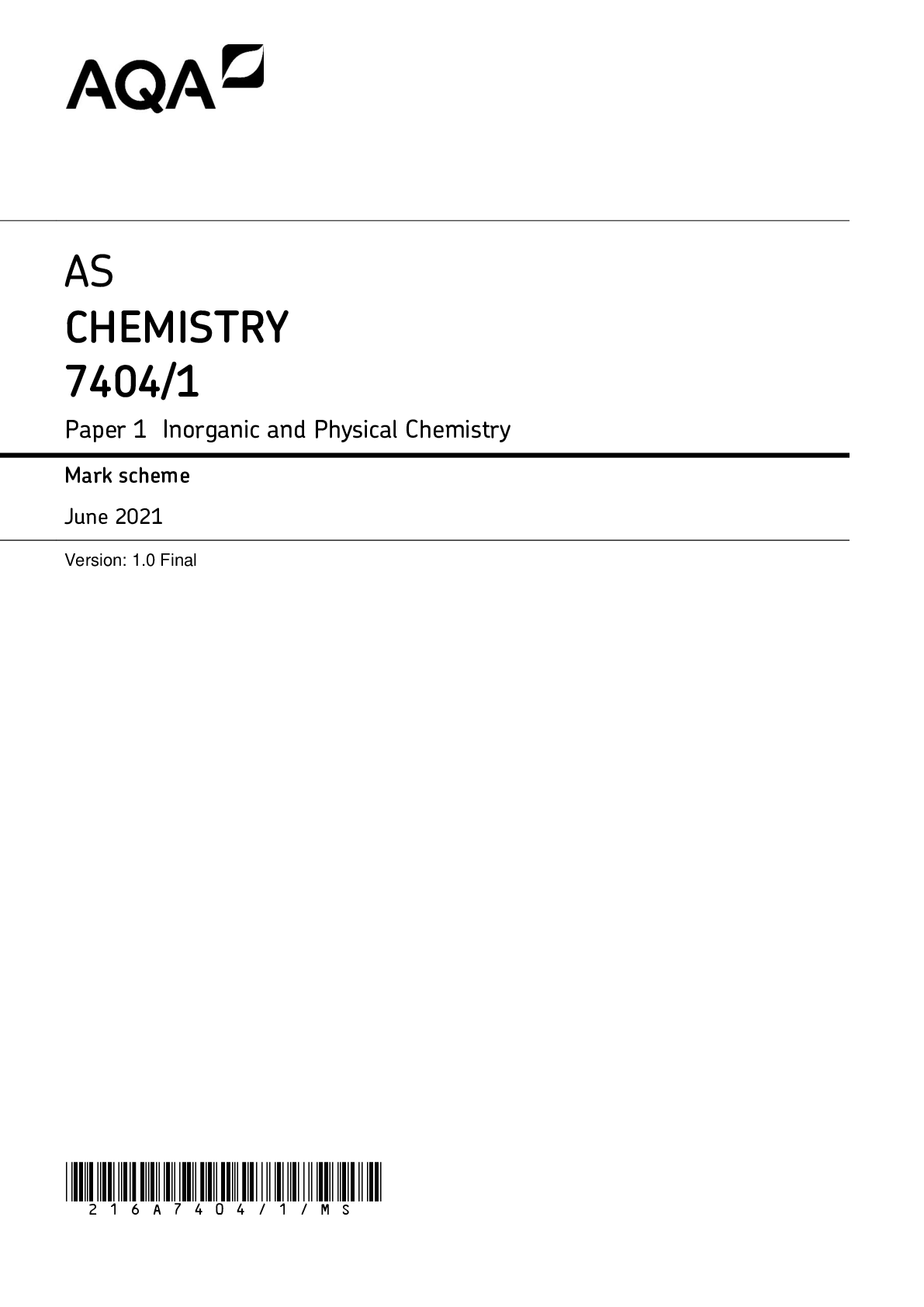



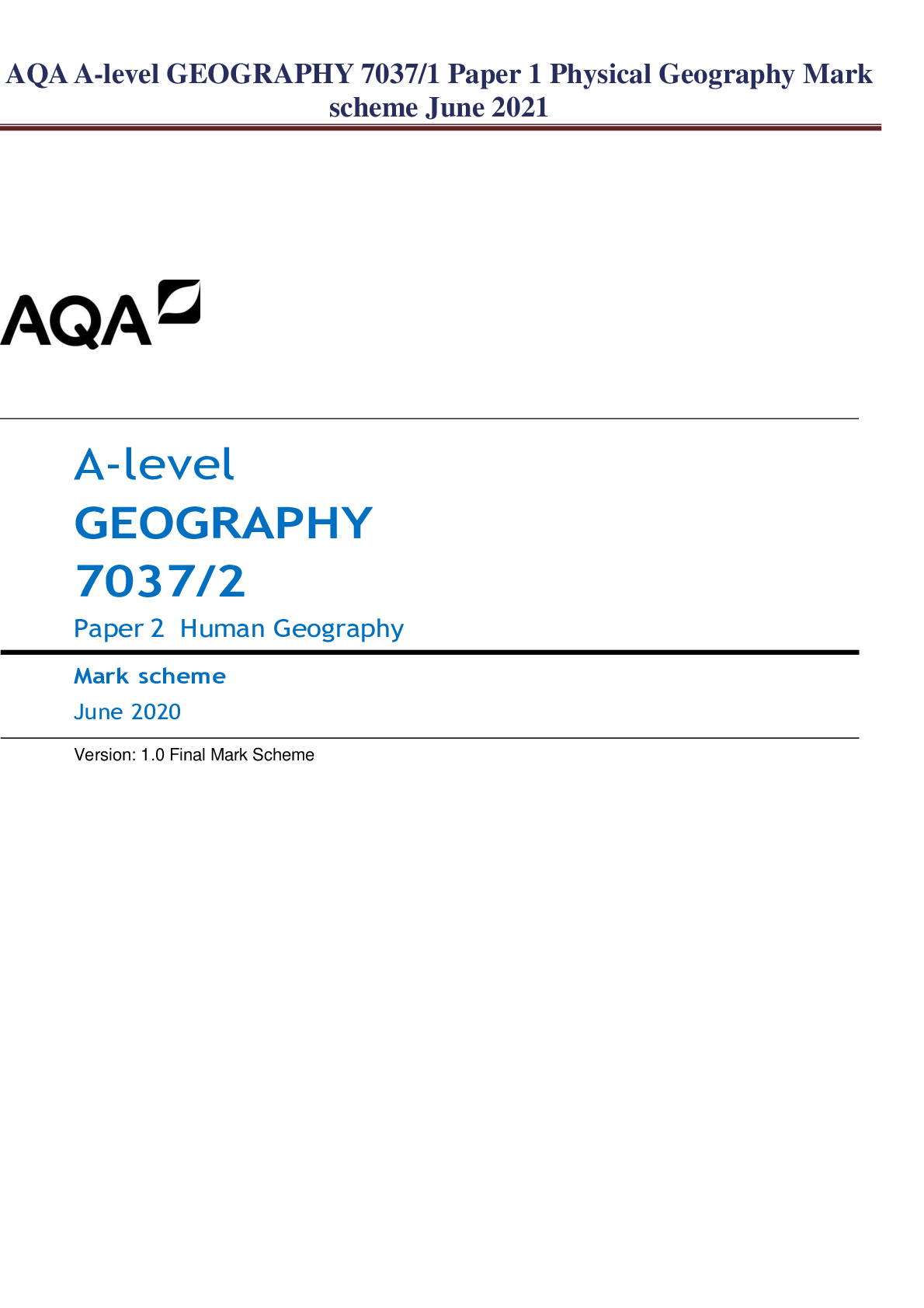
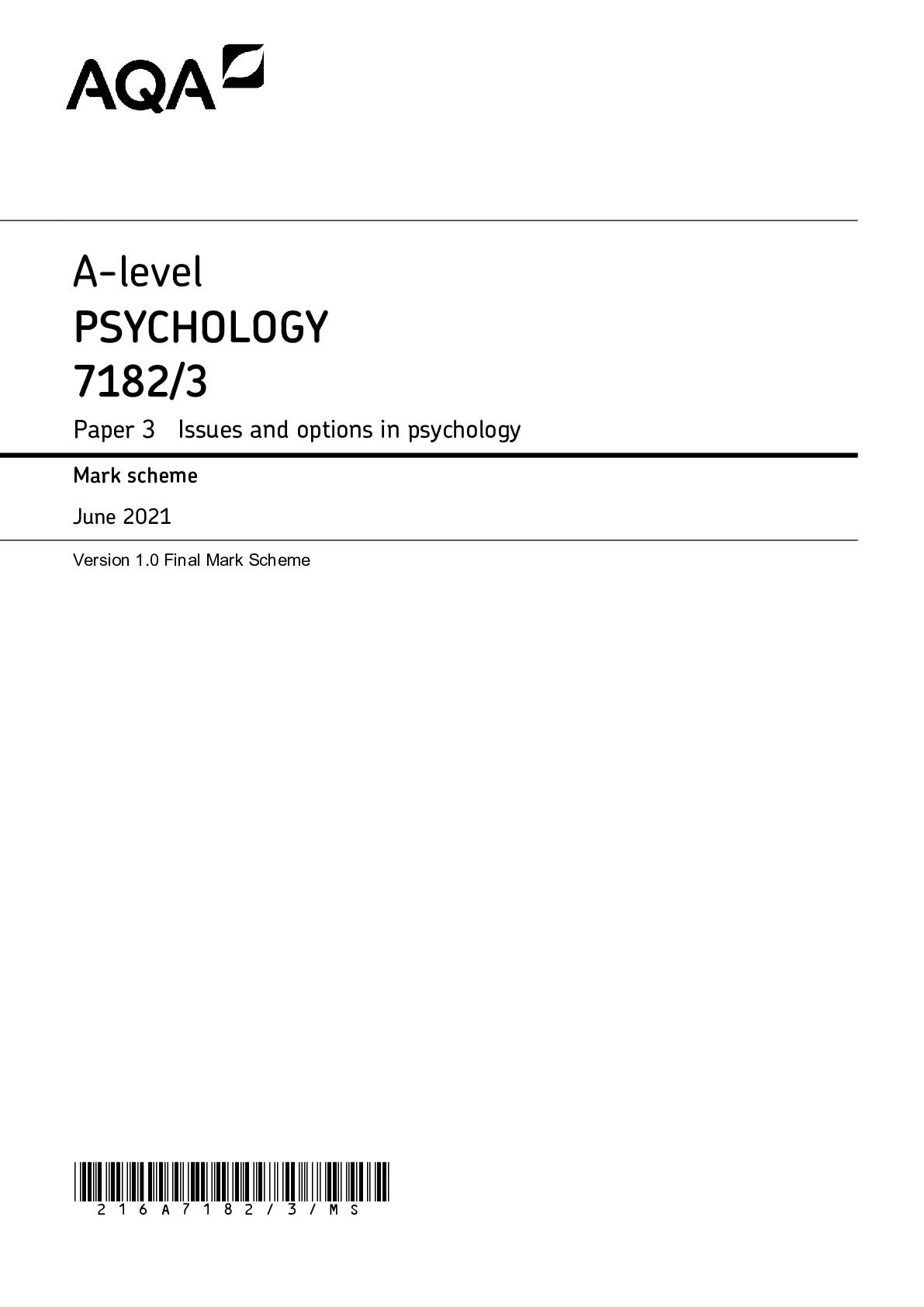
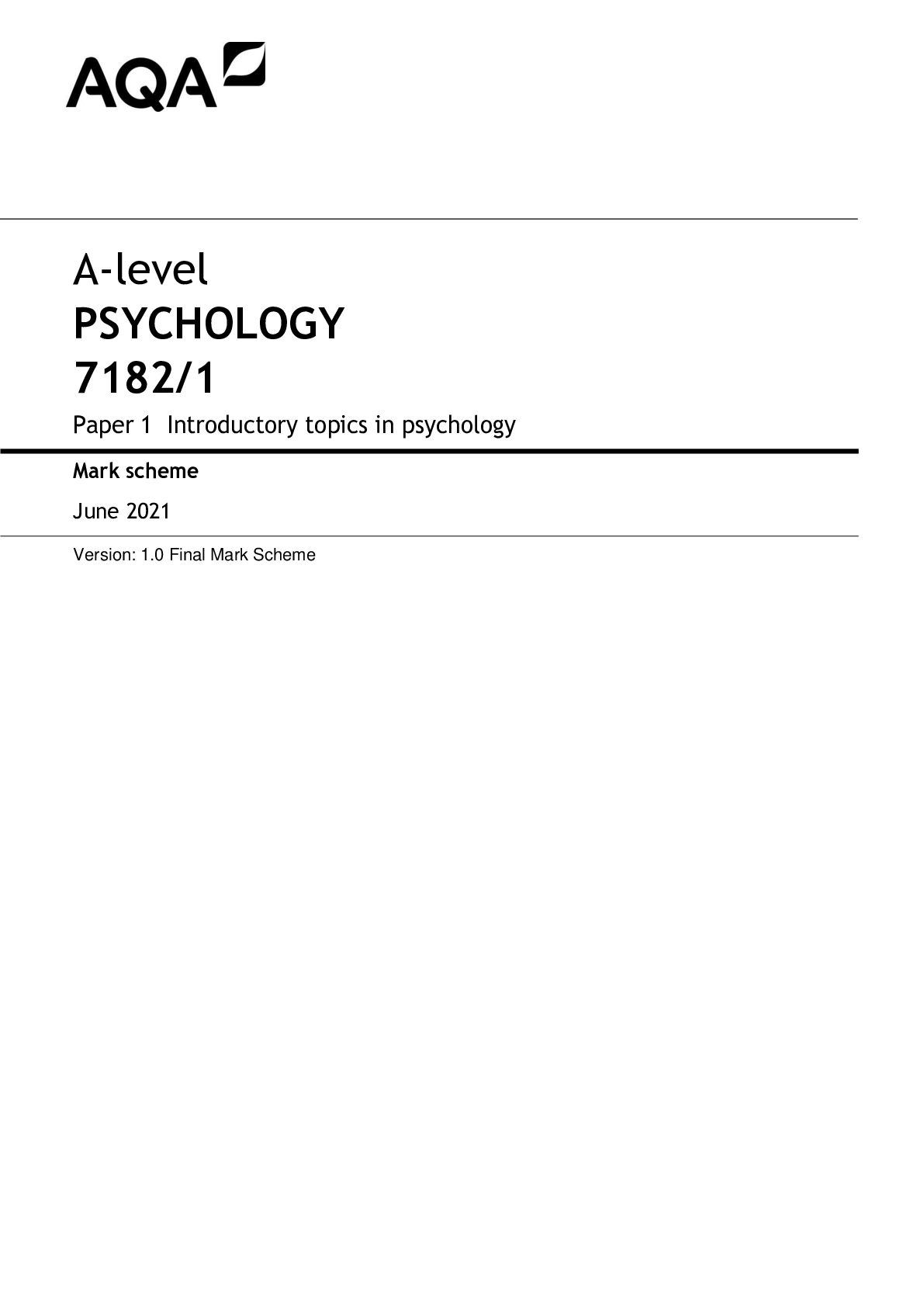
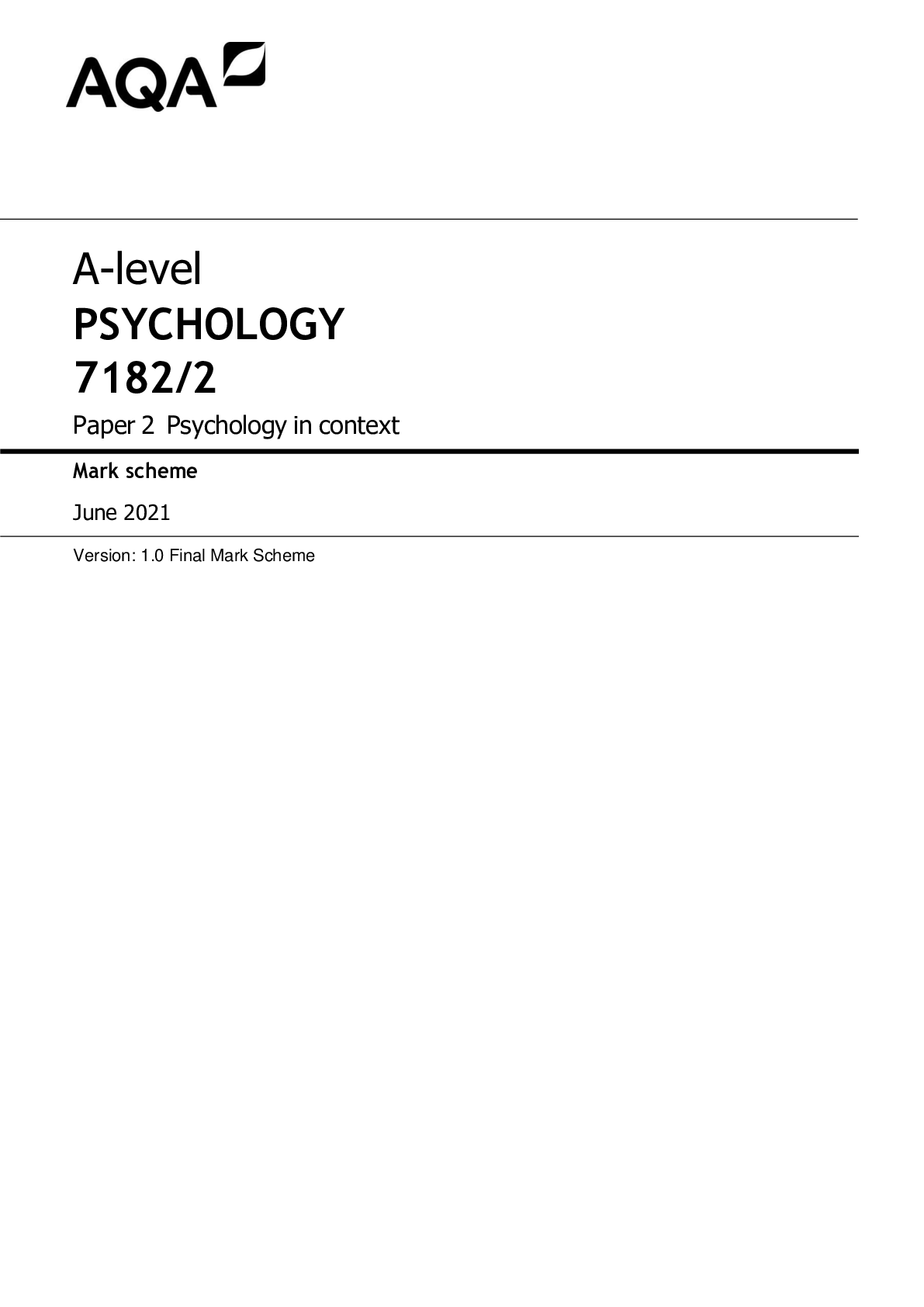
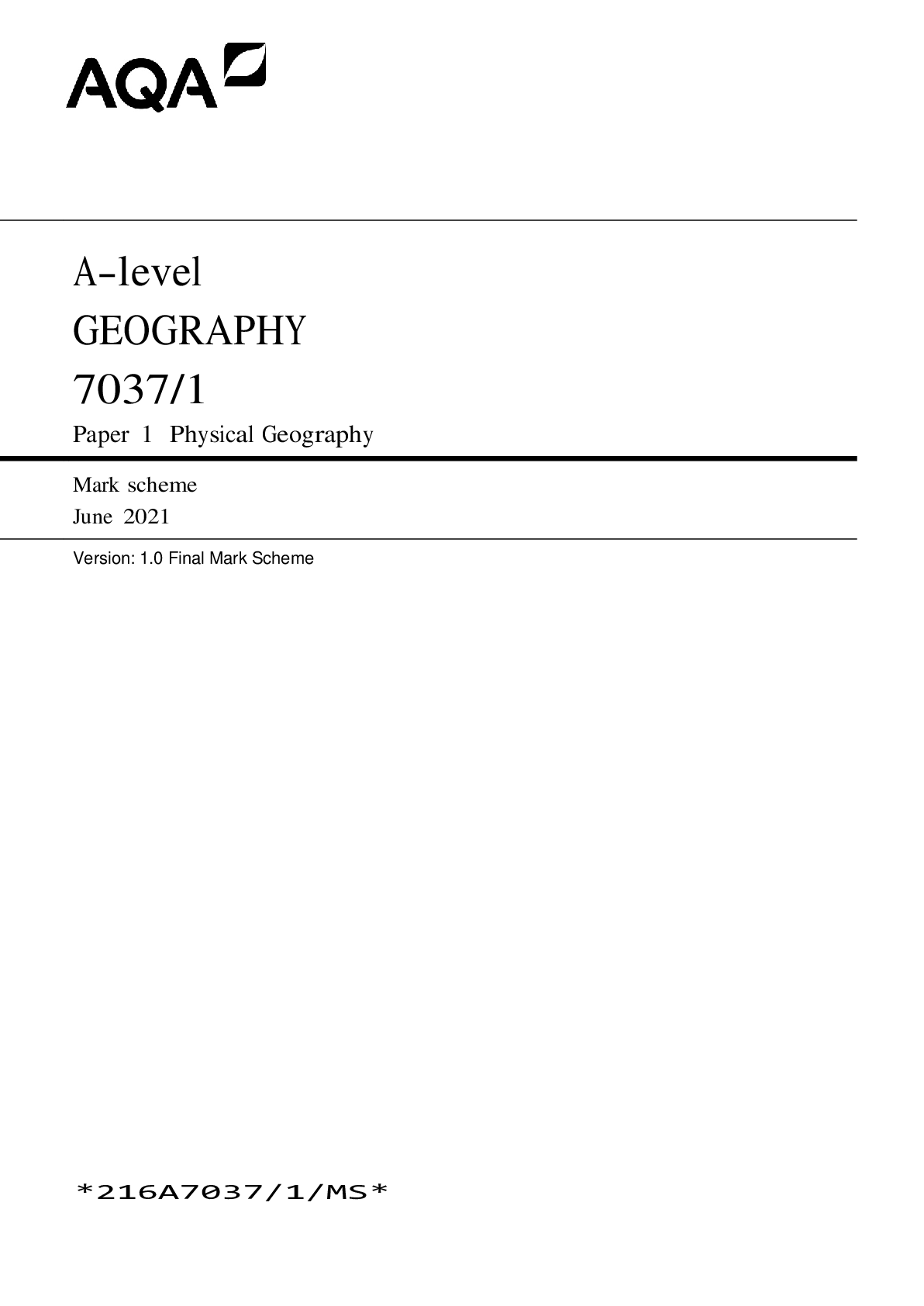
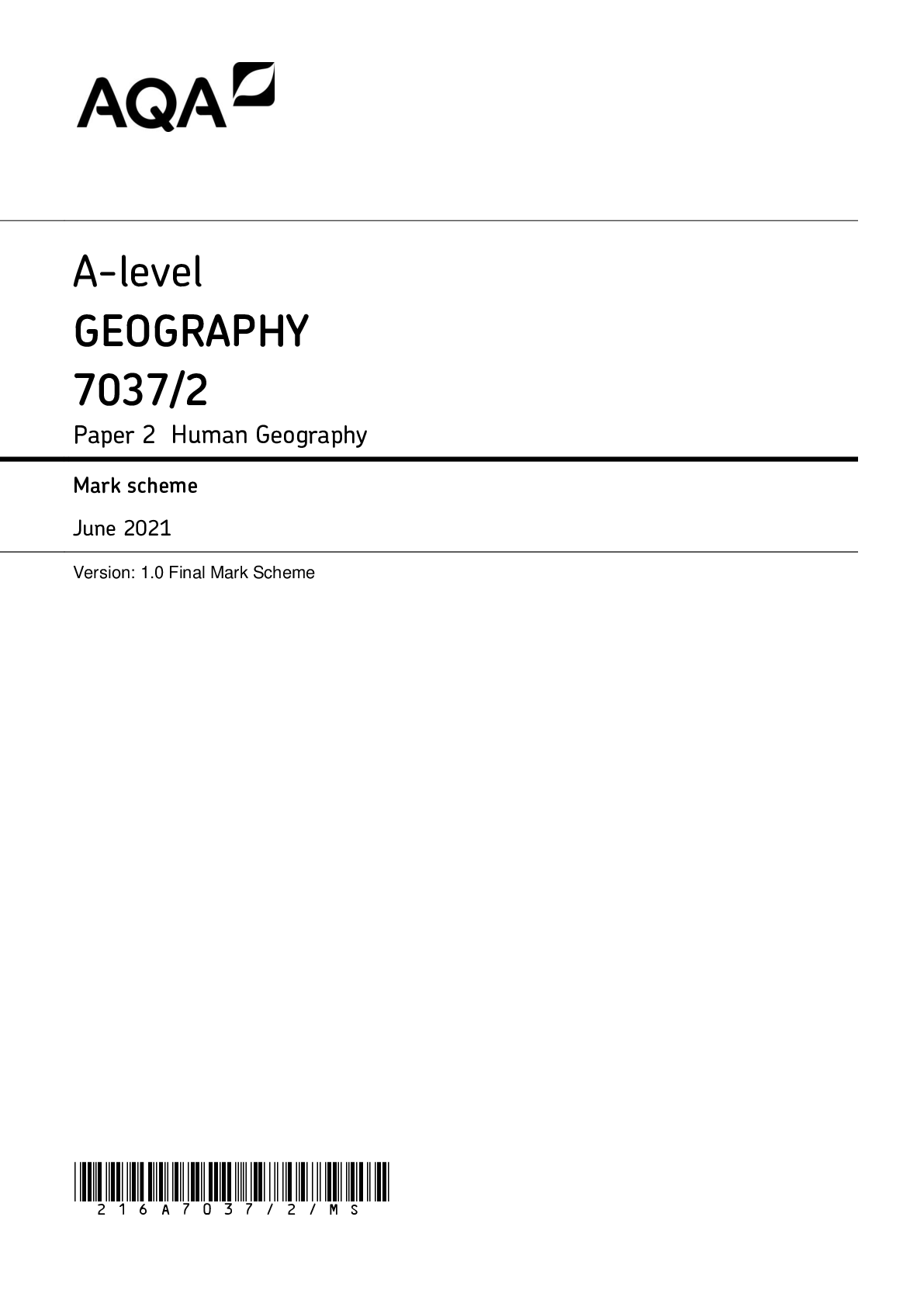
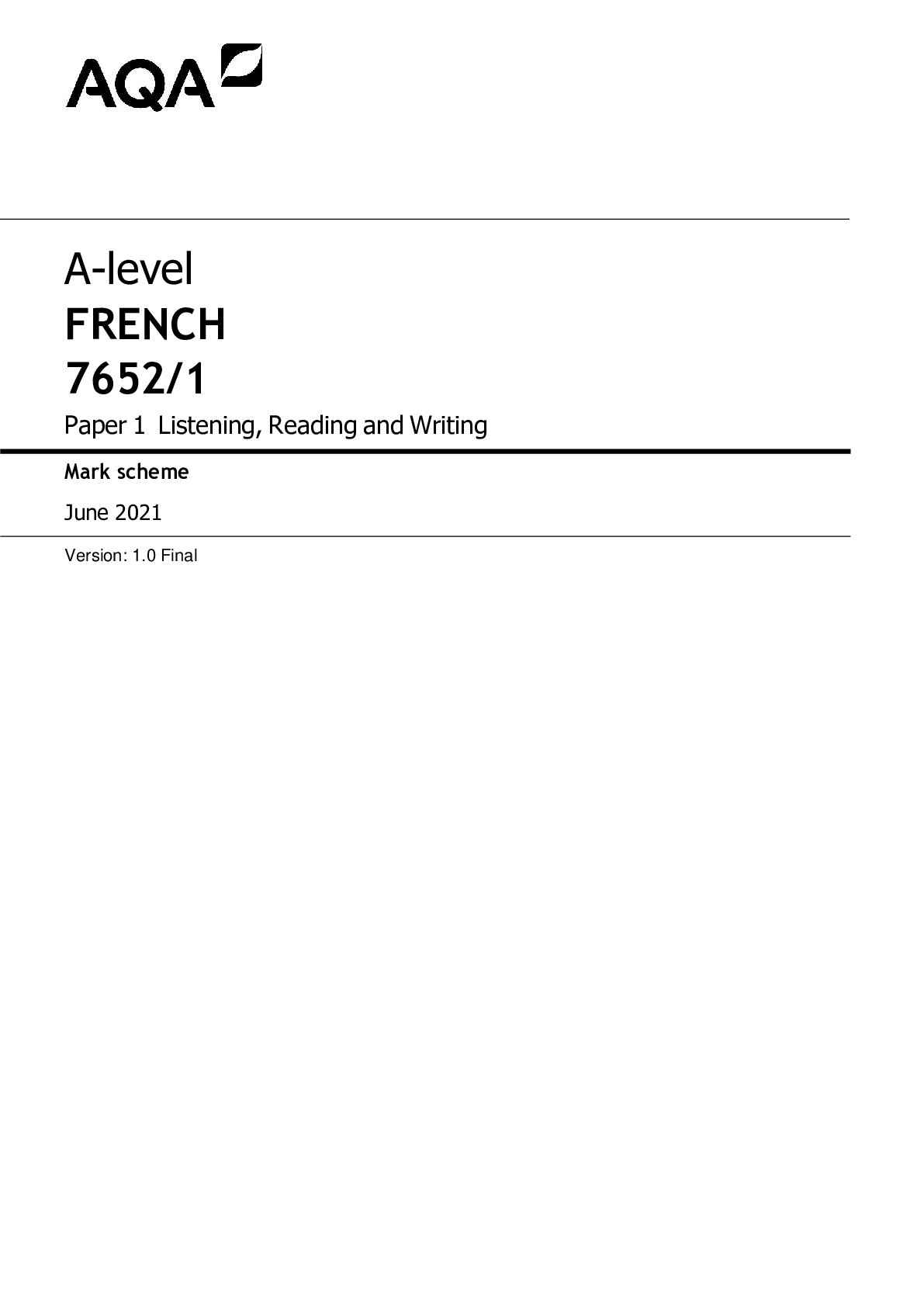
.png)
